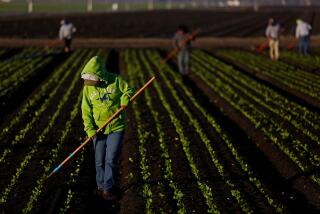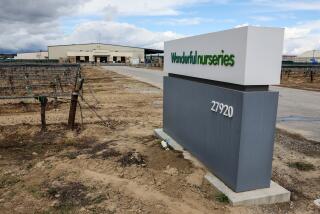700 Farmers March in Capital, Demand Higher Prices
- Share via
WASHINGTON — About 700 Midwestern grain farmers marched outside the Agriculture Department and the White House on Monday, demanding higher guaranteed prices for their products and strict controls on production.
Participants said they want to see both provisions included in the 1985 farm bill that would replace the current law, which expires Sept. 30.
“We’ve got to have higher price supports so that we aren’t forced to sell our products below the cost of production,” said Tom Curl, a farmer from Clinton, Ill., who helped organize the march.
‘Beyond Our Control’
“We can’t make a profit under the present system. Many of us are shoved out of business by forces beyond our control,” he said.
The march, sponsored by the American Agriculture Movement Inc., started with an outdoor rally at the Jefferson Memorial in a chilly drizzle.
After short speeches from AAM leaders and farm-state congressmen, the protesters, many carrying placards, walked about two miles to the Agriculture Department building for another rally. Then they held a demonstration on the Ellipse, the circular park south of the White House.
District of Columbia police estimated that there were 700 marchers, considerably fewer than the protest organizers had predicted.
On Tractors Last Time
The protest contrasted with one six years ago in which American Agriculture Movement farmers drove tractors through Washington, belching smoke, ripping up grass on the Mall and snarling traffic.
“We are in Washington because this is where our problems originate, and this is where the solutions must come from,” said Corky Jones, president of the AAM.
“We’re seeing family farmers, Main Street businesses, agriculture banks and the entire rural economic system fall to its knees. And we’re simply not going to stay home and farm ourselves out of business,” he said.
Production Controls
The AAM, organized in the Plains states in 1977, is seeking a new farm bill that would control production to keep prices stable and that would provide commodity loan rates of at least 70% of parity to reflect farmers’ costs.
Parity is an indicator of farmers’ buying power based on prices received and the costs of living in the period 1910-1914. The concept has lost some of its significance, partly because it does not take into account dramatic increases in farm productivity since the early 1900s.
Farm commodity prices in the last several years have been weak. Part of the reason is that huge crop surpluses, a global recession and the strong dollar overseas have reduced demand for U.S. food exports.
More to Read
Sign up for Essential California
The most important California stories and recommendations in your inbox every morning.
You may occasionally receive promotional content from the Los Angeles Times.










